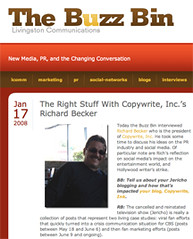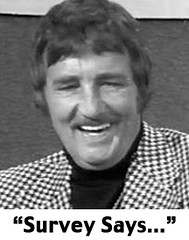Salesgenie.com was not the only SuperBowl advertisement to attempt “ethnic humor,” but it is among the first ads to be pulled amid growing customer complaints.
The New York Times reported yesterday that the spot will be pulled from the airways, though it hasn’t been pulled from the Salesgenie.com Web site as of this morning.
When I first read the article, I thought to give Vinod Gupta, chairman and chief executive of InfoUSA (parent company of Salesgenie.com), some props in handling the public relations fallout over the ad. It makes good sense to apologize and pull the advertisement. That’s responsive.
But in looking at his explanation, I became more skeptical. Gupta, who wrote the advertisements himself, told The New York Times that “We never thought anyone would be offended. The pandas are Chinese. They don’t speak German.”
Well, pandas don’t really speak so who really knows.
In looking at the ad again, perhaps I can offer some explanation for Gupta why the pandas drew more criticism than Salesgenie.com’s Ramesh spot, which also employed accents. Unlike the Ramesh spot, which also wasn’t very good, the pandas cross the fine line between laughing with people and laughing at people.
If Gupta believed his own explanation, then Salesgenie.com’s “psychic” panda would have a Chinese accent too. She does not. She also adds separation between Salesgenie.com’s apparently ignorant target audience and the wisdom of the company. The spot just isn’t good enough to carry any comedy.
The Ramesh spot, on the other hand, doesn’t drive home such separation, with exception to the quip about “having seven children,” which is why it didn’t draw criticism. However, there’s another reason too. The spot isn’t good enough to generate any emotion. It just lands flat.
I faced a similar call last year when a client asked me to add in ethnic accents on the tail end of a radio spot. Instead, I wrote the scripts two ways, and the one without accents survived. Why? Because accents aren’t funny. Specific people are funny, whether or not they have an accent makes no difference at all.
Case in point, it’s not funny to learn that people have been making fun of Gupta’s accent for years. What might be funny is a CEO laughing at his own wit and having “yes men” follow him around agreeing with whatever comes out of his mouth. You know, as if he just came up with the best SuperBowl commercials of the year. It might not even be that far from the truth, because this is the second year Gupta-written Salesgenie.com commercials were disliked.
The New York Times attributed the backlash to being indicative of increasing consumer sensitivity to marketing messages, particularly when ethnic images are involved. Hmmm … I think it is indicative of increasing consumer sensitivity to dumbed down marketing messages, particularly when the only people who like them are the creators. Right on. When you can’t be funny, shoot for publicity. Yuk, yuk, yuk. Yawn.
For another funny, check out MultiCultClassics, where I read Gupta is ready to pick up his pen next year too. I can hear his staff in back ground right now, “Brilliant idea! You're one funny guy.”

The New York Times reported yesterday that the spot will be pulled from the airways, though it hasn’t been pulled from the Salesgenie.com Web site as of this morning.
When I first read the article, I thought to give Vinod Gupta, chairman and chief executive of InfoUSA (parent company of Salesgenie.com), some props in handling the public relations fallout over the ad. It makes good sense to apologize and pull the advertisement. That’s responsive.
But in looking at his explanation, I became more skeptical. Gupta, who wrote the advertisements himself, told The New York Times that “We never thought anyone would be offended. The pandas are Chinese. They don’t speak German.”
Well, pandas don’t really speak so who really knows.
In looking at the ad again, perhaps I can offer some explanation for Gupta why the pandas drew more criticism than Salesgenie.com’s Ramesh spot, which also employed accents. Unlike the Ramesh spot, which also wasn’t very good, the pandas cross the fine line between laughing with people and laughing at people.
If Gupta believed his own explanation, then Salesgenie.com’s “psychic” panda would have a Chinese accent too. She does not. She also adds separation between Salesgenie.com’s apparently ignorant target audience and the wisdom of the company. The spot just isn’t good enough to carry any comedy.
The Ramesh spot, on the other hand, doesn’t drive home such separation, with exception to the quip about “having seven children,” which is why it didn’t draw criticism. However, there’s another reason too. The spot isn’t good enough to generate any emotion. It just lands flat.
I faced a similar call last year when a client asked me to add in ethnic accents on the tail end of a radio spot. Instead, I wrote the scripts two ways, and the one without accents survived. Why? Because accents aren’t funny. Specific people are funny, whether or not they have an accent makes no difference at all.
Case in point, it’s not funny to learn that people have been making fun of Gupta’s accent for years. What might be funny is a CEO laughing at his own wit and having “yes men” follow him around agreeing with whatever comes out of his mouth. You know, as if he just came up with the best SuperBowl commercials of the year. It might not even be that far from the truth, because this is the second year Gupta-written Salesgenie.com commercials were disliked.
The New York Times attributed the backlash to being indicative of increasing consumer sensitivity to marketing messages, particularly when ethnic images are involved. Hmmm … I think it is indicative of increasing consumer sensitivity to dumbed down marketing messages, particularly when the only people who like them are the creators. Right on. When you can’t be funny, shoot for publicity. Yuk, yuk, yuk. Yawn.
For another funny, check out MultiCultClassics, where I read Gupta is ready to pick up his pen next year too. I can hear his staff in back ground right now, “Brilliant idea! You're one funny guy.”































